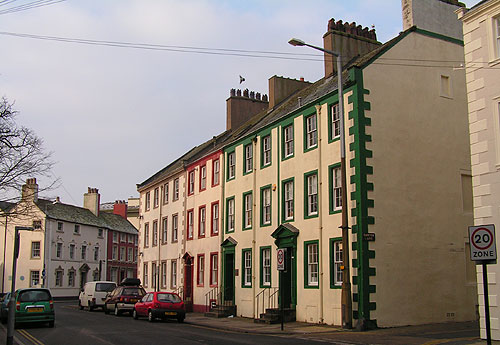

Scotch Street was first suggested as the name of a new street by Sir John Lowther in 1698 in order to encourage Scottish merchants to settle here. It numbers from the town end but the first on the corner actually has its entrance on Roper Street and was once owned by James Spedding the son of Carlisle Spedding. Scotch Street starts with tidy rows of terraced Georgian style houses either side of Carter Lane that extend as far as the Fox Lane.
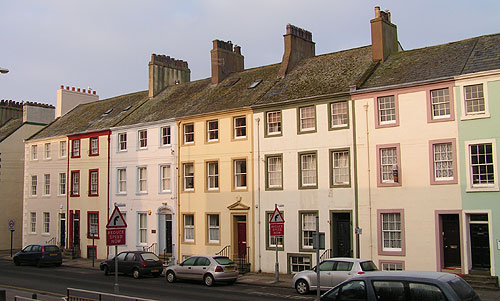
On the opposite side of the street is Trinity Court, which extends behind the two terraced houses fronting Scotch Street to a large set of flats that run the depth of the Trinity Gardens that they overlook.
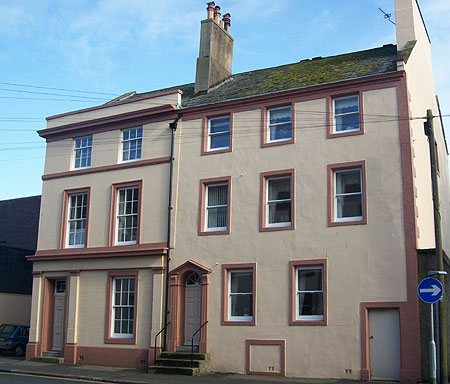
The two houses though side by side on the same street vary in style quite considerably on close inspection. One has windows with fenestration divided into much smaller pains in the Georgian style pilasters either side of the door and at the end of the wall support a (cornice/lintel) that splits the house into tiers and a parapet wall that hides the pitched roof and maintains a classical appearance. The first floor windows have finely moulded surrounds. The house on the right is more of the local vernacular with a much plainer appearance, except for the door way that has is classical pediment and semicircular fanlight.
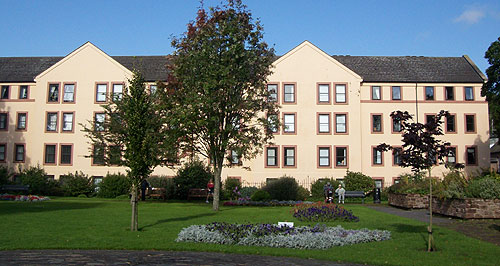
The flats indicate how the Georgian style can easily be adopted to provide cheap modern housing. These gardens were the grounds of the old Trinity church, built in 1715 and demolished in 1947. It still contains many of the interesting old gravestones around the edge but has been brightened up by attractive flower beds. A labyrinth was created as a centre piece in the millennium year.
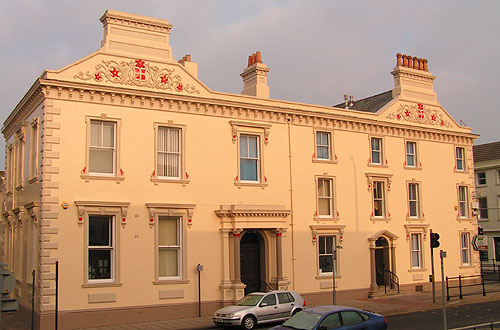
The corner of Scotch Street has had its houses removed to make way for the Civic halls on Lowther Street but on the west side is the imposing 1880 building, Union Hall, with its Italianate style. Ironically this lavish building was home to the Poor Law Union that catered for the those that had fallen into poverty before the days of state benefits. It appears to be two buildings - the one on the left with larger proportions for windows and door but the twin gables, chimneys and ornamentation combining as a whole.
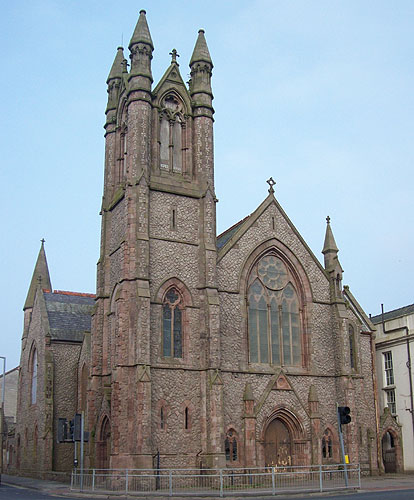
Diagonally across the road we have the old Methodist church built in 1877, although Methodism had been present since the time of John Wesley who visited Whitehaven several times. The building cost around £10,000 and is interesting for its Gothic design by T.L. Banks with a unique stone cladding possibly of pink granite from Eskdale. It sits on the site of an old mansion built by Walter Lutwidge.
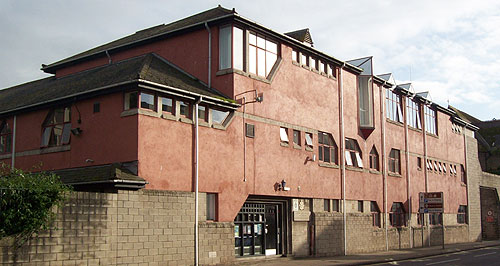
On the site of the old Congregational church which stood from 1874 to 1980 we now have the Whitehaven police station. When it was built in the 1980's the joke was that somewhere in Milton Keynes was an elegant Georgian style police station. Of course, being a Government building, it wasn't subject to planning guidelines or good taste. One has to admire the courage to throw out symmetry and proportion and introduce exposed concrete blockwork with white plastic drain pipes, whilst disguising the entrance as a series of windows.
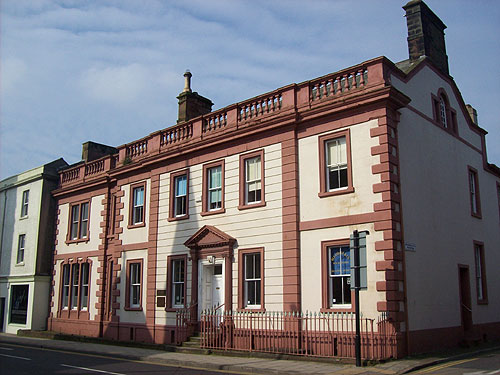
Across the road is the much more elegant premises of Bleasdales solicitors which incidentally had a World War II air raid shelter in the basement. An interesting feature is the heavy balustrade on the roof parapet also seen on the Westminster building in Lowther street. Though appearing, unusually, to be only 2 storeys a palladian window high in the gable indicates rooms in the roof. Other features are the banded rustication on the middle section seen on some Irish Street buildings and a particular fine classical doorway with fluted ionic columns topped by a well proportioned pediment. There has been a building on this site since before Read's painting of c.1738 and it was occupied by Isaac Littledale in around 1830 when possibly the facade was altered to this style.
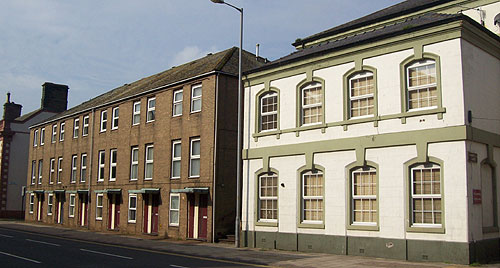
Between Schoolhouse Lane and Sandhills Lane is modern accommodation that has kept roughly Georgian proportions without trying to create a facsimile. Also on this block is the old County Court building with its wide arch topped windows. Schoolhouse lane is named after the first school that was built at the wishes of the townsmen and with funds from Sir John Lowther.
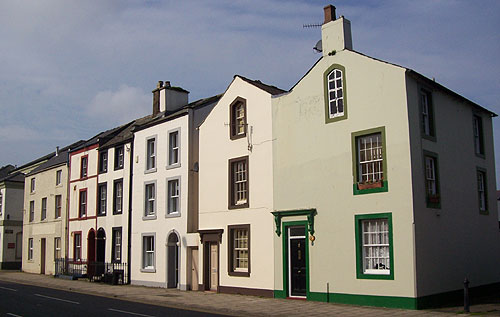
The nearest two houses above are unusual for having their gable ends facing the street and one has a false window in the chimney to correlate with its neighbour. These houses end at Plumblands Lane.
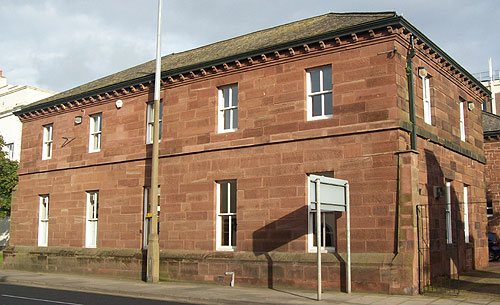
Across the road is the old Victorian police station which is a very sturdy looking building which housed jail cells. Constructed of local sandstone it now houses the Whitehaven section of the county archives and is a great resource for people studying local history and genealogy.
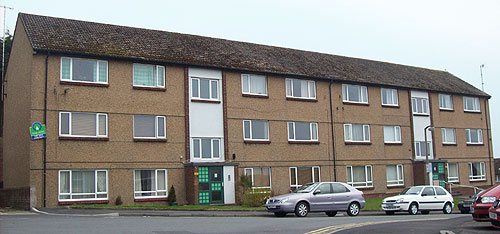
These flats at the top of Scotch St. stand on the site of what was known as High Brewery at the end of the 18th century. The next ones down, also built in the 1960's, are on the site of the workhouse. The area was later taken over by the tannery on High Street to which it was connected by a bridge. The Scotch Street workhouse built in 1743 was enlarged in 1795 to accommodate 200 female paupers. It was one of several that Whitehaven has had.
The first was on Duke Street, another for the Preston Quarter was on Low Road, 1745-1855, for 200 male inmates. The Whitehaven Union Workhouse, on Low Road, was built in 1855 for over 400 inmates and eventually became a hospital for geriatric patients called Meadow View House.
© WAWL 2009